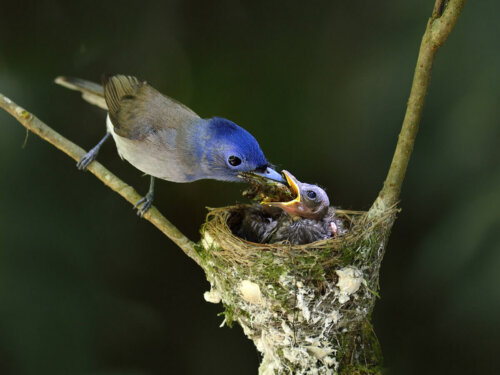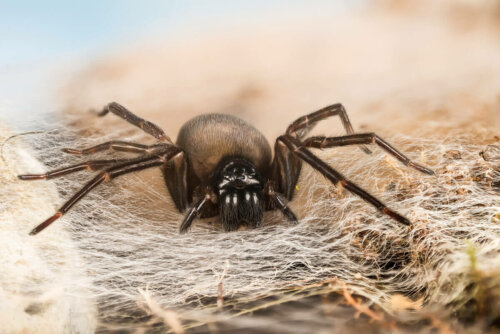The Characteristics and Significance of Matriphagy


Written and verified by the biologist Samuel Sanchez
Some parents would give their lives for their children. In fact, these kinds of altruistic paternal behaviors are present both in the animal kingdom and in most human societies. Even so, there are extreme parental strategies that go far beyond protecting the offspring and this is the case with matriphagy.
Do you know what this term means? Do you know what its purpose is? Continue reading to find out the answer to these and more questions.
Parental care and its relationship to offspring
Parental care is defined as any parental trait that increases the chances of offspring survival, and their reproductive viability. This mechanism is present in both behavioral and non-behavioral traits.
In addition, parental care isn’t a process that comes for free, because in all cases parents must share precious resources and energy from the very beginning. Every bite they give to their offspring is one they don’t have for themselves. Thus, it manifests in animals such as:
- Invertebrates – and when it does happen it’s mainly present in females
- Male fish take care of their offspring
- Birds use a type of biparental care in which both sexes work to raise their offspring
- Female mammals are usually in charge of the offspring
Offspring is an investment for parents as they must limit their own possibilities of future survival and reproduction in order to provide the best possible future for their children.

What’s matriphagy?
Matriphagy is the most extreme type of parental care. In fact, this kind of animal eats its own mother. This behavior mainly takes place in invertebrates and in the caecilians, a group of amphibians.
This process isn’t complete in the latter because the mother doesn’t die as food to her little ones. Female caecilians allow their offspring to feed on their oviduct tissue, which causes damage but doesn’t end their lives.
A specific case of matriphagy: the Amaurobius ferox
This small-sized spider is distributed throughout Europe and North America. Beyond their image, common to many arachnids, the main characteristic of females of this species is their extreme altruism towards their offspring.
In this case, a female keeps the ootheca (egg sac) until the young emerge from it. She first lays the second batch of eggs to feed them, and then encourages them to feed on her own body. The hatchlings inject their venom into the mother’s body and so she dies quickly.
The benefits of this strategy to the hatchlings are more than clear. Some of them are:
- The mother’s body is a source of nutrition, which translates into better offspring development
- Matriphagy accelerates the molting process (invertebrates change their exoskeletons after periodic intervals of time, and this parental strategy shortens them)
- The young that feed on their mothers have a much higher survival rate than those of the species that don’t
- Matriphagy promotes gregariousness among the members of the offspring since it prevents processes such as cannibalism among siblings
A scientific study
It’s clear that offspring benefit from this behavior in multiple ways. What’s in it for the mother, though? A scientific study tried to answer this question by separating the offspring from the mother before they devoured her in laboratory conditions. The results were:
- 80% of the females separated from their offspring laid a second egg sac. Also, only 40% of the offspring survived, when compared to 90% of the first batch
- The number of eggs laid in the second batch was significantly lower compared to the first
As you can see, these results indicate the female is no longer viable after giving rise to the first generation of offspring. Why bother to do so if the chances of survival of the second batch of eggs are so low?

A matter of genes
In the end, genetics has an answer for all evolutionary strategies. Most animals don’t perceive themselves as autonomous entities (or, at least, they haven’t been shown to), so their primary concern is for their genes to live forever.
Now you know why some parents will give their lives to protect their offspring, some even let them eat them alive so they can thrive. Matriphagy is a shocking concept to a human being but it obviously has a clear evolutionary purpose.
”My mother never breast fed me; she told me she only liked me as a friend.”
-Rodney Dangerfield-
All cited sources were thoroughly reviewed by our team to ensure their quality, reliability, currency, and validity. The bibliography of this article was considered reliable and of academic or scientific accuracy.
- Kim, K. W., Roland, C., & Horel, A. (2000). Functional value of matriphagy in the spider Amaurobius ferox. Ethology, 106(8), 729-742.
- Kim, K. W., & Horel, A. (1998). Matriphagy in the spider Amaurobius ferox (Araneidae, Amaurobiidae): an example of mother‐offspring interactions. Ethology, 104(12), 1021-1037.
This text is provided for informational purposes only and does not replace consultation with a professional. If in doubt, consult your specialist.